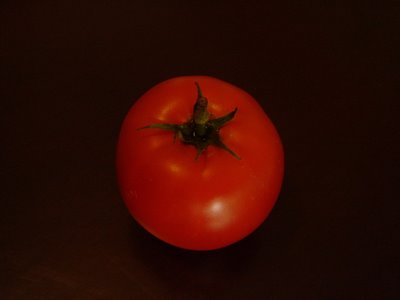
This is a beautiful tomato from my farm. This plant was planted 4 months ago and has produced some fruits just this week. Too bad I'm still on my fast so I can't taste the gorgeous fruit.
Tomato (Solanum lycopersicum) is technically a fruit - the ripened ovaries of a plant, as are squash and peppers. Researchers have traced the tomato to South America and are thought to have originated in the west coast making its way to Central America. After the conquest of South America by the Spanish, the tomato was distributed to Europe and the colonies in the Caribbean and the Philippines. From the Philippines it traveled to Southeast Asia then to the entire Asian continent. The tomato is not only a delicious fruit used in many dishes around the world but is highly nutritious as well. Tomatoes are high in antioxidants that help prevent heart decease and several forms of cancer. The most potent cancer fighting component in tomatoes is found in the gene that makes a tomato red. This gene contains the antioxidant lycopene which is found in all red tomatoes, the redder the tomato the higher the concentration of lycopene. Tomatoes are also high in vitamins C & A, potassium and fiber.
Antioxidants "neutralize", or render harmless, oxygen free radical molecules. Free radicals in our body are precursors of cancer, atherosclerosis, cataracts, and age-related muscular degeneration as well as premature aging. Free radicals are highly reactive toxic by-products of bio-chemical reactions that occur both as a part of normal cell metabolism and when our bodies are exposed to smoking, pollution and other damaging environmental influences. Antioxidants also helps to prevent formation of oxidized LDL, the 'bad' cholesterol in blood, which contributes to the build up of plaque that narrows, stiffens and constricts arteries and can lead to heart attacks.
Our bodies do not naturally produce lycopene so we must get it from other sources. Lycopene is found in pink grapefruit, watermelon, mango and tomato.
Unlike some fruits and vegetables that are nutritionally better when eaten raw, tomatoes are better eaten when cooked. Processing tomatoes decreases its water content making a product that has more lycopene per unit than a fresh tomato. Cooked tomatoes increase the concentration of lycopene so the best way to get a healthy dose of antioxidants from tomatoes is to cook them into sauces. Since tomatoes are lipophilic, which means their nutritional value is increased when cooked in some fat, add a little olive oil or cheese in order for your body to better absorb the lycopene and other vitamins. Yum!
The flavor of the tomato needs to develop by ripening on the vine. Tomatoes are bland when plucked from the vine when it is still green or unripe. Most grocery bought tomatoes are plucked green for a longer shelf life. Purchase tomatoes that are vine-ripened and organic. Storing tomatoes in the fridge will also cause it to loose flavor. The best is to keep tomatoes in a basket at room temperature; it will last for about a week. I've kept mine for a lot longer that way. Over ripe tomatoes are excellent for sauces.
No comments:
Post a Comment